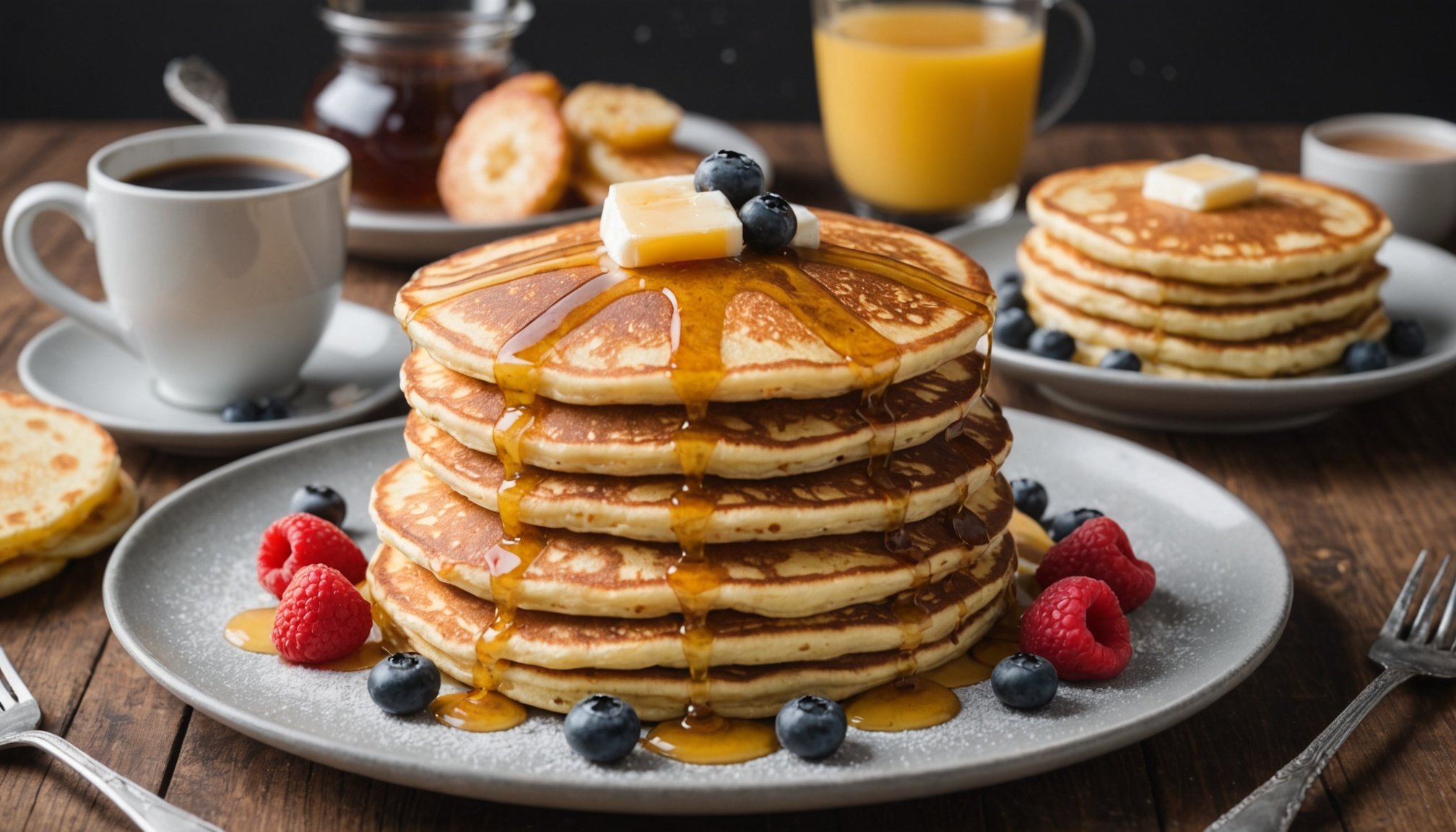Essential Ingredients for English Pancakes
Creating light pancakes and a delicious, fluffy texture requires attention to the finest details of ingredient selection. The right flour is crucial, as it serves as the foundation for the pancake batter. Opt for plain flour with a low protein content to yield a lighter consistency and more elastic batter. This ensures the pancakes achieve that classic fluffy quality.
When it comes to pancake batter essentials, the role of eggs and dairy is significant. Eggs not only provide structure but also contribute to a richer flavour. They help bind the ingredients together and create an airy, soft bite. Adding milk or buttermilk introduces moisture, giving the pancakes their tender crumb and golden hue.
Also read : Unlocking the Secrets to a Delightfully Creamy and Zesty Lemon Posset: Tips and Tricks!
Another key ingredient is baking powder, responsible for the pancakes’ rise. However, using too much can lead to an unpleasant aftertaste and excessive fluffiness that collapses. Generally, a teaspoon per cup of flour strikes the right balance, providing the perfect lift without overpowering other ingredients.
Cooking with flour, eggs, dairy, and a dash of baking powder ensures every bite is a delightful experience. Mastering the science behind these essentials will elevate your pancake game and captivate your taste buds.
In the same genre : Unlocking the Secrets to Mouthwatering Roast Turkey Infused with Herb Butter Delights!
Step-by-Step Recipe for Light and Fluffy English Pancakes
Creating the perfect English pancake recipe isn’t just about the ingredients; it’s about mastering the process and enjoying the journey!
Preparing the Batter
To start, gather your ingredients: plain flour, eggs, milk, and a pinch of salt. First, sift the flour into a bowl and create a well in the center. Crack two eggs into the well and gradually incorporate them with the flour. Slowly add the milk while whisking continuously to avoid lumps, forming a smooth batter. Let it rest for at least 30 minutes to absorb the flavours, enhancing the fluffiness.
Cooking Techniques
When it’s time for cooking, temperature control is key. Heat a non-stick frying pan over medium heat, lightly coated with oil or butter. Pour a ladle of batter into the pan, swirling gently for an even coating. Cook each side until golden brown, flipping carefully. Aim for a consistent heat to achieve perfectly cooked, fluffy pancakes.
Serving Suggestions
For a delightful finish, top your pancakes with fresh berries, a drizzle of honey, or a sprinkle of sugar. Pair your creation with a cup of hot tea or a freshly squeezed juice for a truly comforting experience. Get creative with toppings to add a personal touch to this classic treat!
Techniques for Achieving Maximum Fluffiness
Creating fluffy pancakes involves a blend of science and skill. The pancake texture is greatly influenced by the use of leavening agents like baking powder and baking soda, which release carbon dioxide bubbles that expand the batter during cooking. This process is essential for the light and airy texture desirable in pancakes. Using these agents in the right amounts will enhance fluffiness, while too much can lead to a soapy taste.
Incorporating air into the batter requires gentle mixing. Over-mixing can deflate the batter, resulting in dense pancakes. A tip for achieving fluffy pancakes is to separate the eggs, whisk the egg whites until they hold peaks, and then fold them gently into the batter. This technique adds additional air, contributing to the pancake’s lightness.
Resting the batter is another crucial step. Allowing your batter to rest for about 15-30 minutes gives the flour time to hydrate and the leavening agents a head start, leading to a better rise once the batter hits the pan. This pause improves not only the fluffiness but also enhances the overall pancake texture, making your pancakes soft and airy.
Common Mistakes and Troubleshooting
Navigating the world of pancake cooking can sometimes lead to a few common mistakes. One frequent issue is the undercooked or overcooked pancake. Identifying an undercooked pancake is simple: it’s often pale and lacks that golden brown hue, sticking to the spatula when flipped. Overcooked pancakes, on the other hand, appear dark brown and might taste burnt. Achieving the perfect pancake requires maintaining a consistent medium heat and ensuring each side cooks evenly.
Another problem is the density of the pancake. Dense pancakes can result from overmixing the batter, which activates the gluten, leading to a tougher texture. To solve this, mix until just combined. If you still face this issue, consider adding a bit of baking powder to the batter to introduce lightness and fluffiness.
Adjusting recipes based on dietary needs is crucial for inclusivity in cooking. Whether it’s substituting regular flour with a gluten-free alternative or using almond milk in place of dairy milk, setting the right balance and maintaining original flavours and textures demands experimentation and patience. Understanding these variables and customizing them to suit dietary preferences ensures everyone can enjoy a delicious pancake breakfast.
Variations and Flavor Enhancements
Exploring different flavored pancakes can elevate your breakfast game. A popular way to achieve this is through pancake variations where adding ingredients like fruits, spices, or even savory elements can transform a simple batter into something extraordinary.
Incorporating Fruits
Fruits such as berries and bananas are excellent additions to pancakes, offering natural sweetness and vibrant flavours. Try folding blueberries directly into the batter for bursts of juiciness or top the pancakes with freshly sliced strawberries for a refreshing touch. Bananas not only add flavor but also increase the pancake’s moistness. For a caramelized twist, consider sautéing the bananas in butter and sugar before incorporating them.
Chocolate and Spice Additions
For those with a sweet tooth, adding chocolate chips or cocoa powder into your pancake batter can be a delightful option. Imagine biting into a pancake laced with gooey chocolate or a hint of cinnamon and nutmeg for a spiced treat. These elements add warmth and depth to your pancakes, making them more enticing.
Savory Alternatives
Not all pancakes need to be sweet. Savory pancake variations can be just as delicious. Incorporate ingredients like cheese, herbs, or even bacon for a satisfying alternative. Spinach and feta or cheddar and chive combinations can turn a simple pancake into a complete meal.
Visual Aids and Additional Resources
Participating in the culinary world as a visual learner can be highly rewarding. For those looking to perfect their pancake-making skills, there are numerous recommended video tutorials available. These videos guide users through each step of the process in a clear, engaging manner. Platforms like YouTube offer a plethora of options, from quick guides to detailed explorations of various pancake recipes.
Infographics can also serve as valuable tools, breaking down the process into easily digestible parts. They typically cover essentials such as ingredient measurements, ideal cooking temperatures, and flipping techniques. These cooking visuals provide a quick reference that can greatly enhance understanding and facilitate learning.
For those who prefer traditional methods, numerous reputable cookbooks and online recipe collections are available. Websites dedicated to cuisine, such as BBC Good Food or AllRecipes, offer a bounty of well-tested pancake recipes.
Cookbooks such as “Joy of Cooking” and “The Pancake Handbook” deliver authoritative insights along with step-by-step guidance. Accessing these pancake making resources—whether visual or textual—can greatly enhance one’s cooking prowess, catering to both novice cooks and seasoned chefs looking to diversify their pancake repertoire.











